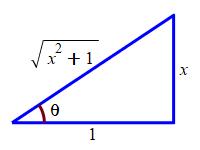7. Trigonometric Substitutions
a1. Substitutions for \(x^2+1\) - Tangent Substitutions
Recall the derivative and integral formulas for \(\arctan x\): \[ \dfrac{d}{dx}\arctan x=\dfrac{1}{x^2+1} \qquad \qquad \qquad \int \dfrac{1}{x^2+1}\,dx=\arctan x+C \] and the second Pythagorean Trig Identity: \[ \tan^2\theta+1=\sec^2\theta \]
These formulas motivate the following integration technique:
If the integrand involves the quantity \(x^2+1\) then it may be useful to make the substitution \(x=\tan\theta\). Then \(dx=\sec^2\theta\,d\theta\) and \(x^2+1=\tan^2\theta+1=\sec^2\theta\). So it may be possible to re-express the integrand in terms of \(\tan\theta\) and \(\sec\theta\) only.
Here are some examples:
Compute \(\displaystyle \int \dfrac{1}{\sqrt{x^2+1}}\,dx\).
We substitute \(x=\tan\theta\). Then \(dx=\sec^2\theta\,d\theta\) and so \[\begin{aligned} \int \dfrac{1}{\sqrt{x^2+1}}\,dx &=\int \dfrac{1}{\sqrt{\tan^2\theta+1}}\,\sec^2\theta\,d\theta \\ &=\int \dfrac{1}{\sqrt{\sec^2\theta}}\,\sec^2\theta\,d\theta =\int \sec\theta\,d\theta \\ &=\ln|\sec\theta+\tan\theta|+C \end{aligned}\] Don't forget to substitute for the differential! Don't forget to substitute back! We already know that \(\tan\theta=x\) from the definition of the substitution. We also need a formula for \(\sec\theta\) in terms of \(x\). There are two ways to find this formula:
We can use the Pythagorean identity \(\tan^2\theta+1=\sec^2\theta\). Then: \[ \sec\theta=\sqrt{\tan^2\theta+1}=\sqrt{x^2+1} \]
We can draw a right triangle with an angle \(\theta\) whose opposite side is \(x\) and whose adjacent is \(1\). These sides are chosen so that \(\tan\theta=\dfrac{x}{1}=x\). Then the hypotenuse is \(\sqrt{x^2+1}\) and so: \[ \sec\theta=\dfrac{\text{HYP}}{\text{ADJ}} =\dfrac{\sqrt{x^2+1}}{1}=\sqrt{x^2+1} \]

Returning to the problem at hand, we conclude: \[ \int \dfrac{1}{\sqrt{x^2+1}}\,dx =\ln\left|\sqrt{x^2+1}+x\right|+C \]
We check by differentiating. If \(f(x)=\ln\left|\sqrt{x^2+1}+x\right|\) then \[\begin{aligned} f'(x) &=\dfrac{1}{\sqrt{x^2+1}+x}\left(\dfrac{1}{2}\dfrac{2x}{\sqrt{x^2+1}}+1\right) \\ &=\dfrac{1}{\sqrt{x^2+1}+x}\left(\dfrac{x+\sqrt{x^2+1}}{\sqrt{x^2+1}}\right) =\dfrac{1}{\sqrt{x^2+1}} \end{aligned}\] which is the integrand we started with.
Compute \(\displaystyle \int \dfrac{x}{\sqrt{x^2+1}}\,dx\).
We substitute \(x=\tan\theta\). Then \(dx=\sec^2\theta\,d\theta\) and so: \[\begin{aligned} \int \dfrac{x}{\sqrt{x^2+1}}\,dx &=\int \dfrac{\tan\theta}{\sqrt{\tan^2\theta+1}}\sec^2\theta\,d\theta =\int \dfrac{\tan\theta}{\sqrt{\sec^2\theta}}\sec^2\theta\,d\theta \\ &=\int \tan\theta\sec\theta\,d\theta=\sec\theta+C =\sqrt{x^2+1}+C \end{aligned}\] This solution was unnecessarily complicated. Always look for an ordinary substitution first:
Let \(u=x^2+1\). Then \(du=2x\,dx\) or \(\dfrac{1}{2}\,du=x\,dx\). So: \[ \int \dfrac{x}{\sqrt{x^2+1}}\,dx =\dfrac{1}{2}\int \dfrac{1}{\sqrt{u}}\,du =\sqrt{u}+C=\sqrt{x^2+1}+C \]
Now it's your turn:
Compute \(\displaystyle \int \dfrac{1}{(x^2+1)^{3/2}}\,dx\).
Let \(x=\tan\theta\).
\(\displaystyle \int \dfrac{1}{(x^2+1)^{3/2}}\,dx =\dfrac{x}{\sqrt{1+x^2}}+C\)
We substitute \(x=\tan\theta\). Then \(dx=\sec^2\theta\,d\theta\) and so: \[\begin{aligned} \int \dfrac{1}{(x^2+1)^{3/2}}\,dx &=\int \dfrac{1}{(\tan^2\theta+1)^{3/2}}\sec^2\theta\,d\theta \\ &=\int \dfrac{1}{\sec^3\theta}\sec^2\theta\,d\theta =\int \dfrac{1}{\sec\theta}\,d\theta \\ &=\int \cos\theta\,d\theta=\sin\theta+C \end{aligned}\] Examining the triangle, we see \(\sin\theta=\dfrac{\text{OPP}}{\text{HYP}}=\dfrac{x}{\sqrt{1+x^2}}\). So: \[ \int \dfrac{1}{(x^2+1)^{3/2}}\,dx =\dfrac{x}{\sqrt{1+x^2}}+C \]
We check by differentiating. If \(f(x)=\dfrac{x}{\sqrt{1+x^2}}\), then \[\begin{aligned} f'(x) &=\dfrac{\sqrt{1+x^2}(1)-x\dfrac{2x}{2\sqrt{1+x^2}}}{x^2+1} \\ &=\dfrac{(1+x^2)-x^2}{(x^2+1)^{3/2}} \\ &=\dfrac{1}{(x^2+1)^{3/2}} \end{aligned}\] which is the integrand we started with.
Compute \(\displaystyle \int_0^1 \dfrac{x^3}{(x^2+1)^{3/2}}\,dx\).
Use the ordinary substitution \(u=x^2+1\).
\(\displaystyle \int_0^1 \dfrac{x^3}{(x^2+1)^{3/2}}\,dx =\dfrac{3}{2}\sqrt{2}-2\)
We use the ordinary substitution \(u=x^2+1\). Then \(du=2x\,dx\) or \(\dfrac{1}{2}\,du=x\,dx\) and \(x^2=u-1\). Further, \[\begin{aligned} \text{If} \quad x=1 \quad & \text{then} \quad u=2. \\ \text{If} \quad x=0 \quad & \text{then} \quad u=1. \end{aligned}\] So: \[\begin{aligned} \int_0^1 \dfrac{x^3}{(x^2+1)^{3/2}}\,dx &=\dfrac{1}{2}\int_1^2 \dfrac{u-1}{u^{3/2}}\,du =\dfrac{1}{2}\int_1^2 (u^{-1/2}-u^{-3/2})\,du \\ &=\dfrac{1}{2}\left[\dfrac{}{}2u^{1/2}+2u^{-1/2}\right]_1^2 =\left[\dfrac{}{}u^{1/2}+u^{-1/2}\right]_1^2 \\ &=\left(\sqrt{2}+\dfrac{1}{\sqrt{2}}\right)-(1+1) =\dfrac{3}{2}\sqrt{2}-2 \end{aligned}\]
Heading
Placeholder text: Lorem ipsum Lorem ipsum Lorem ipsum Lorem ipsum Lorem ipsum Lorem ipsum Lorem ipsum Lorem ipsum Lorem ipsum Lorem ipsum Lorem ipsum Lorem ipsum Lorem ipsum Lorem ipsum Lorem ipsum Lorem ipsum Lorem ipsum Lorem ipsum Lorem ipsum Lorem ipsum Lorem ipsum Lorem ipsum Lorem ipsum Lorem ipsum Lorem ipsum